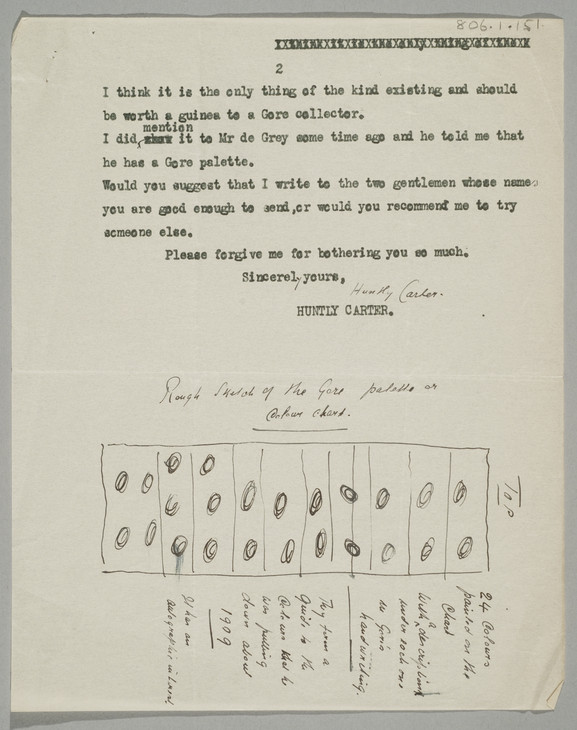Huntly Carter Letter to James Bolivar Manson 17 April 1935
Huntly Carter was an art and theatre critic who wrote for the New Age (1909–12), the New Freewoman (1912) and the Egoist (1914–19). He also published many books, including The New Spirit in Drama and Art (1912), Women’s Suffrage and Militancy (1912), The Theatre of Max Reinhardt (1914), The New Theatre and Cinema of Soviet Russia (1924), The New Spirit in the European Theatre, 1914–24 (1925), The New Spirit in the Russian Theatre, 1917–28 (1929) and The New Spirit in the Cinema (1930). Carter was an advocate and friend of many members of the Fitzroy Street and Camden Town groups.
In this letter to then Director of the Tate Gallery, James Bolivar Manson, Carter writes that he is in possession of a colour chart made by Spencer Gore, who had died prematurely in 1914. Carter states that ‘The chart shows him [Gore] breaking with the Sickert tradition of low tones and a rather dirty palette & turning to ... the new French clean palette tradition’. Alongside a sketch of the chart Carter writes that ‘24 colours [are] painted on the chart with a description under each one in Mr Gore’s handwriting’; ‘They form a guide to the colours that he was putting down about 1909’.
Transcript
[Typescript with some handwritten corrections:]
THE STUDIO.
WINDMILL HILL.
OLD HAMPSTEAD. N.W.3.
17.4.35.
WINDMILL HILL.
OLD HAMPSTEAD. N.W.3.
17.4.35.
J.B. Manson, Esq.
Director. Tate Gallery.
Dear Sir.
Director. Tate Gallery.
Dear Sir.
Let me thank you for your letter with its useful suggestions.
I am afraid that I have led you to attach more importance to the Gore item, than belongs to it.
Perhaps its correct description is a colour chart, not a “palette”. I got the word “palette” from Robert Bevan when he suggested that I should make a collection of colour “palettes” of his progressive contemporaries for the purpose of describing them in a series of articles. Each arranged his colours on a chart with written descriptions underneath.
Gore did so with the result indicated in the rough sketch appended.
The chart has a sentimental, aesthetic, technical and historical interest, and I think deserves to be added to a Gore collection especially by a collector who has concentrated his attention mainly upon Gore and has collected his work and material that show the various stages of his career. The chart shows him breaking with the Sickert tradition of low tones and a rather dirty palette & turning to to [sic] the new French clean palette tradition. [end of p.1]
I am afraid that I have led you to attach more importance to the Gore item, than belongs to it.
Perhaps its correct description is a colour chart, not a “palette”. I got the word “palette” from Robert Bevan when he suggested that I should make a collection of colour “palettes” of his progressive contemporaries for the purpose of describing them in a series of articles. Each arranged his colours on a chart with written descriptions underneath.
Gore did so with the result indicated in the rough sketch appended.
The chart has a sentimental, aesthetic, technical and historical interest, and I think deserves to be added to a Gore collection especially by a collector who has concentrated his attention mainly upon Gore and has collected his work and material that show the various stages of his career. The chart shows him breaking with the Sickert tradition of low tones and a rather dirty palette & turning to to [sic] the new French clean palette tradition. [end of p.1]
2
I think it is the only thing of the kind existing and should be worth a guinea to a Gore collector.
I did mention it to Mr de Grey some time ago and he told me that he has a Gore palette.
Would you suggest that I write to the two gentlemen whose names you are good enough to send, or would you recommend me to try someone else.
Please forgive me for bothering you so much.
Sincerely yours,
[Huntly Carter signature]
HUNTLY CARTER.
I did mention it to Mr de Grey some time ago and he told me that he has a Gore palette.
Would you suggest that I write to the two gentlemen whose names you are good enough to send, or would you recommend me to try someone else.
Please forgive me for bothering you so much.
Sincerely yours,
[Huntly Carter signature]
HUNTLY CARTER.
[Handwritten:] Rough sketch of the Gore palette or colour chart.
[Sketch of a large rectangle divided into ten sections with two to four circles indicating blobs of colour drawn in each section]
[Handwritten vertically alongside the sketch:]
TOP
24 colours painted on the chart
With a description under each one in Gore’s handwriting.
They form a guide to the colours that he was putting down about 1909
It has an autobiographical interest.
TOP
24 colours painted on the chart
With a description under each one in Gore’s handwriting.
They form a guide to the colours that he was putting down about 1909
It has an autobiographical interest.
How to cite
Huntly Carter, Letter to James Bolivar Manson, 17 April 1935, in Helena Bonett, Ysanne Holt, Jennifer Mundy (eds.), The Camden Town Group in Context, Tate Research Publication, May 2012, https://www


